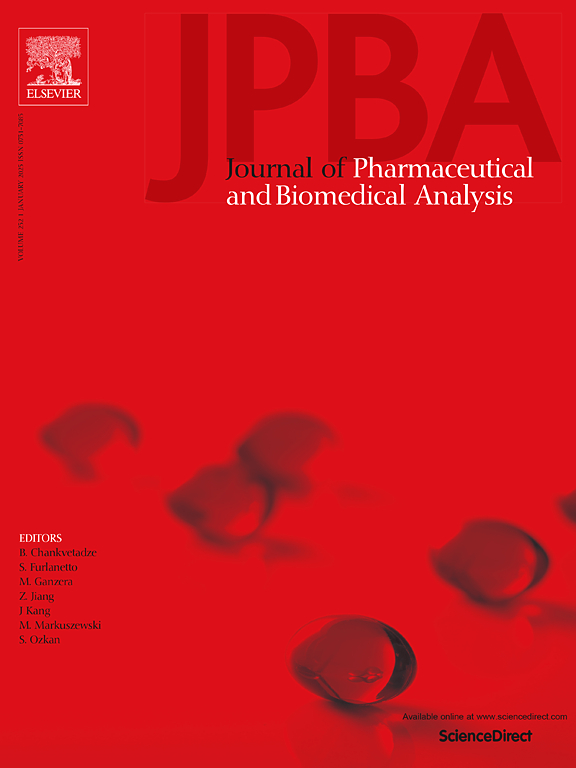Simultaneous determination of thirteen related substances in lenalidomide API by a stability-indicating RP-HPLC method
IF 3.1
3区 医学
Q2 CHEMISTRY, ANALYTICAL
Journal of pharmaceutical and biomedical analysis
Pub Date : 2025-03-17
DOI:10.1016/j.jpba.2025.116823
引用次数: 0
Abstract
The purpose of this study was to develop and validate a high performance liquid chromatography (HPLC) method for the separation and determination of related impurities and potential genotoxic impurity in the lenalidomide API. Chromatographic separation was performed on a Zorbax SB-AQ column (250 mm × 4.6 mm, 5 μm) at a wavelength of 220 nm using pH 4.0 phosphate buffer-acetonitrile as the mobile phase in gradient elution mode. The validation results demonstrate that the method has acceptable specificity, linearity, accuracy, precision and robustness. The detection limits and quantitation limits ranged from 2 to 17 ng/mL and from 6 to 50 ng/mL, respectively. A linear relationship was observed between the peak area and concentration of lenalidomide and impurities, with a correlation coefficient value of r ≥ 0.999. The formation and chemical structures of oxidation and base degradation products of lenalidomide have also been confirmed. The newly developed HPLC method is suitable for use in quality-control laboratories for qualitative and quantitative assessment of thirteen kinds of related substances in the lenalidomide API.
求助全文
约1分钟内获得全文
求助全文
来源期刊
CiteScore
6.70
自引率
5.90%
发文量
588
审稿时长
37 days
期刊介绍:
This journal is an international medium directed towards the needs of academic, clinical, government and industrial analysis by publishing original research reports and critical reviews on pharmaceutical and biomedical analysis. It covers the interdisciplinary aspects of analysis in the pharmaceutical, biomedical and clinical sciences, including developments in analytical methodology, instrumentation, computation and interpretation. Submissions on novel applications focusing on drug purity and stability studies, pharmacokinetics, therapeutic monitoring, metabolic profiling; drug-related aspects of analytical biochemistry and forensic toxicology; quality assurance in the pharmaceutical industry are also welcome.
Studies from areas of well established and poorly selective methods, such as UV-VIS spectrophotometry (including derivative and multi-wavelength measurements), basic electroanalytical (potentiometric, polarographic and voltammetric) methods, fluorimetry, flow-injection analysis, etc. are accepted for publication in exceptional cases only, if a unique and substantial advantage over presently known systems is demonstrated. The same applies to the assay of simple drug formulations by any kind of methods and the determination of drugs in biological samples based merely on spiked samples. Drug purity/stability studies should contain information on the structure elucidation of the impurities/degradants.

 求助内容:
求助内容: 应助结果提醒方式:
应助结果提醒方式:


